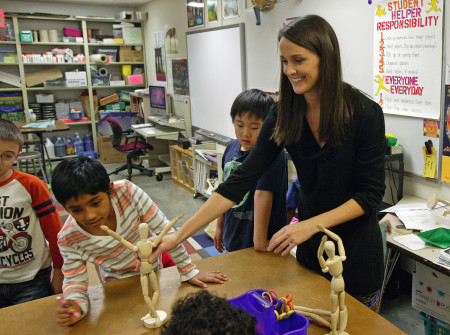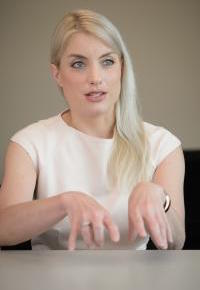 What makes a creative teacher? Is it the ability to seamlessly incorporate real-world lessons into the classroom? Is it about blending outside creative interests with the curriculum? Or is the creative teacher someone who just isn't afraid to take a few risks?
What makes a creative teacher? Is it the ability to seamlessly incorporate real-world lessons into the classroom? Is it about blending outside creative interests with the curriculum? Or is the creative teacher someone who just isn't afraid to take a few risks?
Yes, yes, yes, and more, suggest two scholars at Michigan State University. Danah Henriksen and Punya Mishra, both professors of educational psychology and educational technology, examined how great teachers use creativity in the classroom by interviewing eight recent National Teacher of the Year finalists. They recently released their findings in a new study called "We Teach Who We Are: Creativity in the Lives and Practices of Accomplished Teachers."
The rigid standardization and testing regimes imposed by No Child Left Behind has fostered a climate of conformity and even outright fear in schools across the country. And students are the ones losing out.
"When teachers are deprived of the opportunity to foster creativity in their classrooms, students cannot begin to develop a mastery of critical or creative thinking abilities," Henriksen and Mishra write. Creative teaching, they conclude, is effective teaching.
“Our system overall tends not to value or invest in teaching, or promote individuality or creative approach,” explains Henriksen. “So this study was a chance for us to look at what some of the most noted and successful teachers actually do - to learn more about where and how they express their individuality and creativity in their work, while also succeeding with their students and working within a challenging system.”
The teachers are "all pretty much in the same boat" says Henriksen. "They're navigating the same policy constraints, and they came from a range of different teaching environments, but they were still finding ways to be creative in the classroom."
Though the participants all had unique perspectives on creative teaching, three recurring themes emerged that help bring into focus not only what creative teachers do, but who they are.
 Despite countless policy-related roadblocks, creative teachers can find ways to engage students.
Despite countless policy-related roadblocks, creative teachers can find ways to engage students.
All the teachers interviewed emphasized the importance of "real world learning" or using scenarios that connected to their students' daily lives. "Adam," a high school math teacher, ties in his students' ethnicity when they are learning graphs, using socioeconomic data that will grab their attention and engage them in the lesson.
The educators also integrate subject matter across disciplines. "Mark," a middle school science teacher, is able to fuse the performing arts with a lesson on ecosystems. "Sandra," a high school language arts teacher, uses music in her language arts class to explore "movements" in complex texts that resemble movements in music.
Key to these creative approaches is a readiness to take risks in the classroom.
"I would be willing to bet that many of the really good teachers are not rule followers," Adam said. "I follow the guidelines but I've never been stressed out or fearful of bending or breaking the rules for the sake of the bigger picture of learning."
Mark replied that fear has taken its toll on the teaching profession.
"When teachers are teaching in fear, they take few risks. And ultimately I think that's going to sink our educational system, this sort of fear- based climate that everything's all about achievement, achievement, achievement." He added that his own risk-taking was important behavior to model for his students.
"It needs to be about the ability to try new things, to make mistakes, to learn from them, to collaborate about what happened. For students to see that kind of risk taking and iterative process - I think it helps them to understand how to do things well."
Henriksen says it was evident that some of the teachers interviewed felt they had a supportive administrator, or they had proven themselves for long enough to feel confident in trying new things and ideas.
It is a confidence that is augmented by these educators' own creative pursuits in their daily lives. Six of the eight teachers interviewed, for example, reported that they were "personally engaged" in musical or artistic hobbies and various other interests outside the classroom - all of which they use to enrich their classroom practice.
"Mia" is a third grade teacher and an amateur musician, playing both the piano and violin. She regularly uses musical ideas to engage her students, including asking them to write songs about math topics.
"Using all different learning styles, audio, auditory, visual, kinesthetic, tactile, the kids were creating a song of their own," she recalls. "At test time you see them at their desk, they were bopping out the song - they own it."
"Outside pursuits always factor into your thinking about your classroom or your students," says Sandra, "I think that we teach who we are."
Henriksen cautions that creativity can't necessarily be taught to educators directly but it can be developed.
"We can create teaching and learning environments (or activities for pre- or in-service teachers) that are conducive to helping people think and work creatively," she explains. Henriksen and Mishra recommend that teacher education programs devote more resources into interdisciplinary thinking and training. In addition, they urge administrators to understand the important role they play in creating school cultures where teachers can try new things without fear or repercussions.
But what about those educators, perhaps newer to the classroom, who feel constrained and still haven't quite built the necessary confidence to push boundaries?
Small steps can make a big difference, says Henriksen.
"I would suggest trying new things or creative approaches in small ways and in increments that are comfortable - in essence, 'sneaking' in creative twists wherever an opportunity shows up.
"Creativity sounds daunting if you equate it with major shifts in practice," she adds. "But the biggest myth of creativity is that it always involves sweeping change or groundbreaking newness. More realistically, it's about an ongoing willingness to find the places to make small or interesting changes and watch these add up over time."



